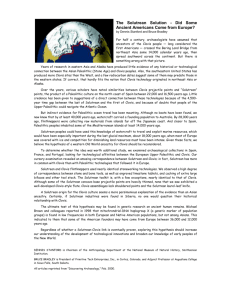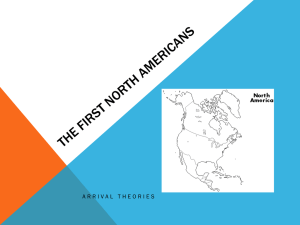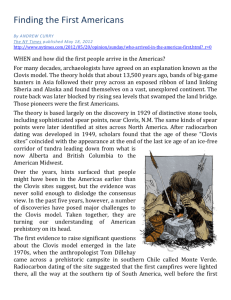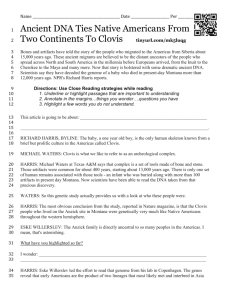The North Atlantic ice-edge corridor: a possible Palaeolithic route to
advertisement
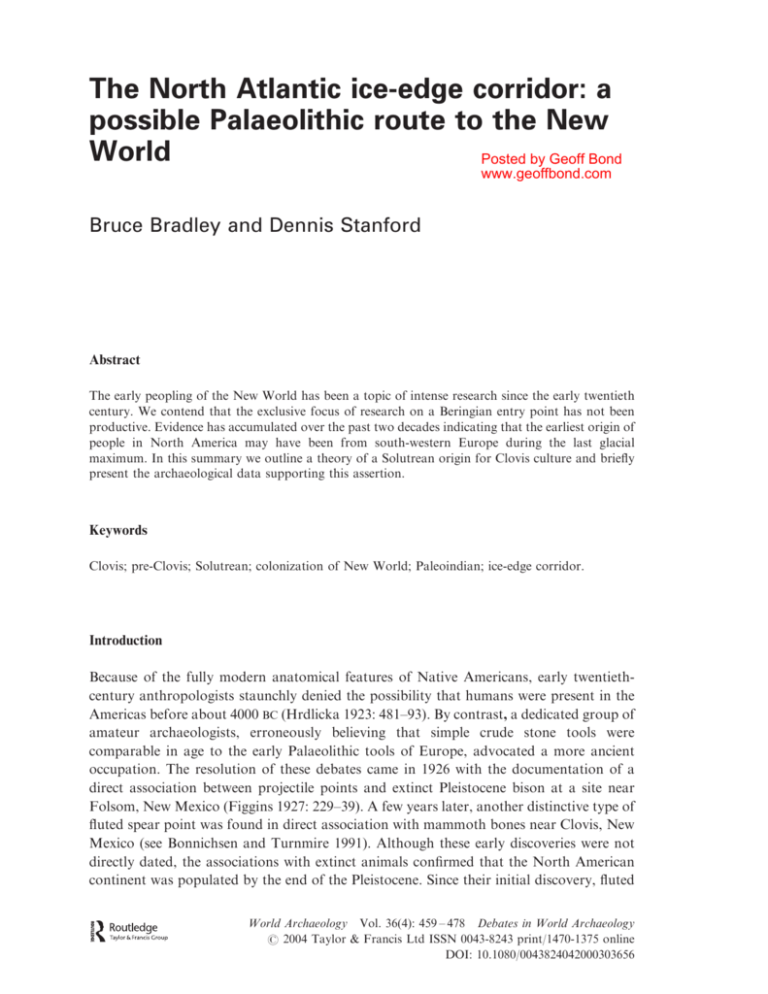
The North Atlantic ice-edge corridor: a possible Palaeolithic route to the New World Posted by Geoff Bond www.geoffbond.com Bruce Bradley and Dennis Stanford Abstract The early peopling of the New World has been a topic of intense research since the early twentieth century. We contend that the exclusive focus of research on a Beringian entry point has not been productive. Evidence has accumulated over the past two decades indicating that the earliest origin of people in North America may have been from south-western Europe during the last glacial maximum. In this summary we outline a theory of a Solutrean origin for Clovis culture and briefly present the archaeological data supporting this assertion. Keywords Clovis; pre-Clovis; Solutrean; colonization of New World; Paleoindian; ice-edge corridor. Introduction Because of the fully modern anatomical features of Native Americans, early twentiethcentury anthropologists staunchly denied the possibility that humans were present in the Americas before about 4000 BC (Hrdlicka 1923: 481–93). By contrast, a dedicated group of amateur archaeologists, erroneously believing that simple crude stone tools were comparable in age to the early Palaeolithic tools of Europe, advocated a more ancient occupation. The resolution of these debates came in 1926 with the documentation of a direct association between projectile points and extinct Pleistocene bison at a site near Folsom, New Mexico (Figgins 1927: 229–39). A few years later, another distinctive type of fluted spear point was found in direct association with mammoth bones near Clovis, New Mexico (see Bonnichsen and Turnmire 1991). Although these early discoveries were not directly dated, the associations with extinct animals confirmed that the North American continent was populated by the end of the Pleistocene. Since their initial discovery, fluted World Archaeology Vol. 36(4): 459 – 478 Debates in World Archaeology # 2004 Taylor & Francis Ltd ISSN 0043-8243 print/1470-1375 online DOI: 10.1080/0043824042000303656 460 Bruce Bradley and Dennis Stanford Clovis-like points have been found from the Atlantic to the Pacific coast and from southern Canada to Central America (Anderson and Gillam 1999). After the late Pleistocene human presence in North America was established, archaeologists sought to explain the origin of the unique Clovis technology. It was thought that the ancestors of Clovis people must have come from Asia by crossing a land bridge, known as Beringia, that connected Siberia and Alaska (Fagan 1991: 67). This land bridge formed when Ice Age sea levels dropped during the build up of the continental glaciers. The hypothesis continued that, after early populations arrived in Alaska, the glaciers began to melt, creating an ‘ice-free corridor’ between the Arctic and the rest of the Americas. Using the corridor as a migration route, Clovis people spread southward. This theory seems eminently logical as Siberia is only a short distance from Alaska, and North American Indians share many physical traits with north-eastern Asians. Thus, practically all scholars accept the proposition that the bearers of Clovis culture must have come from north-eastern Asia and were the ancestors of modern Native Americans. Alternative routes were not considered since they would have required the use of watercraft, and it is inconceivable that Palaeolithic people had either the technical skills or the material culture to have crossed an Ice Age sea. We must remember that these ideas on New World origins are based on informed speculation and are not supported by archaeological evidence. Through time and repetition, and in the absence of any clear alternatives, the theory has become dogma, and ultimately ideology, appearing in all textbook and popular publications. Over the past fifty years, archaeologists have expended a great deal of effort and resources trying to find evidence of Clovis ancestors in Alaska and north-eastern Siberia. In addition, anybody who suggested that there might be an alternative theory relative to either place or time of origin has been immediately discounted (Adovasio and Page 2002). The profession has come full circle, with the time of origin simply moved from 4000 years ago to the end of the Pleistocene, and the only acceptable place of origin being north-east Asia. However, there is a lack of data supporting an Asian connection and the origin of Clovis culture and technology still remains a mystery. The Clovis baseline Although it is well established that Clovis people were in North America by 11,500 14 C BP years ago, there is very little evidence regarding early colonization. New dating techniques have placed many sites in a chronological context, but most Clovis sites are surface manifestations and cannot be directly dated. This is especially true in eastern North America where preservation of organic remains is poor. Nevertheless, it has been possible to document a basic assemblage of stone tool types and technologies that are readily identifiable as Clovis or at least related to Clovis (Meltzer 1993: 106–8). Although there is some variability in tools and technologies, especially in relation to site function, the basic Clovis tool-kit is surprisingly consistent across diverse environments, ranging from the sub-tropics to the sub-arctic. This broad geographic distribution suggests that the tool-kit was designed for effective exploitation of almost any environment. As The North Atlantic ice-edge corridor 461 more sites are found our understanding of this early culture grows, and scholars are recognizing its complexity (Collins 2002). Nevertheless, regardless of either time or space, Clovis artefacts retain an amazing technological consistency. Clovis flint knappers used two basic flaked-stone technologies: bifacial thinning and large blade production. Both of these technologies are characterized by complex reduction strategies and specific sequences of flake and blade removal. Although space does not permit detailed description of these highly sophisticated technologies, we can summarize their salient characteristics. Biface thinning was accomplished by highly organized reduction sequences and the application of a very difficult technique known as overshot flaking. When using this method flakes are struck that cross the entire width of the biface, many times removing a small portion of the edge opposite the striking platform (Bradley 1982). As knappers, we see this method as counter-intuitive: is not the removal of parts of both edges a disadvantage when trying to thin a biface proportionally? One would assume this to be the case, but, when carefully and intentionally executed, this method is incredibly efficient not only in biface thinning but in making bifaces with flat longitudinal cross-sections. Another positive result of this technique is that it produces large thin flakes that make excellent tool blanks. Along with controlled percussion thinning, most Clovis bifaces are basally thinned, with distinctive, well-controlled flakes called flutes. It is fluting that caught the attention of archaeologists because of its rarity in biface industries around the world. Flutes are negative flake scars desired as an end product on the finished artefacts. Inordinate attention has been placed on this interesting technological innovation, to the near exclusion of other traits. But is fluting really so special? In terms of Clovis biface technology, it is evident that fluting was done throughout the flaking sequence (Collins 2002) and is not technically different from other thinning flake removals; it just originates from the base of the preform rather than the side. Its distinctiveness comes from the intentional retention of the flake scar on finished pieces. Although fluting facilitates hafting, it might also have a symbolic meaning. When fluting was accomplished simply as a method of biface thinning, such as seen in Dalton technology (an immediate successor of Clovis in south-eastern North America), the flake scars were usually obliterated by subsequent lateral flaking (Bradley 1997). Large blade production is typical of Clovis assemblages, and is especially common at habitation sites located on abundant sources of good flaking stone in south-eastern North America. Interestingly, blades and blade tools are much less common in the kill/processing sites that dominate the Rocky Mountain and Plains records. As with the bifaces, it is the details of blade production that are of special interest. The most frequent blade production technology resulted in large wedge-shaped cores. These cores have a single acute-angle platform, a single blade production face and a flat back (either cortical or prepared). The reduction sequence of this technology has yet to be completely reconstructed (Collins 1999). Retouched Clovis tools were made both from blades and from large biface thinning flakes. The former are most common at the large settlements, such as Gault in Texas and the latter at most large game kill/processing sites. Formal retouched tool types are limited in number, with side and end scrapers, biface knives, small gravers and weapon points 462 Bruce Bradley and Dennis Stanford being most prevalent. The number of formal tool forms increases with the size of assemblages and especially at habitation sites, where end scrapers, borers, adzes and backed pieces occur. Conspicuously lacking or rare are burins. Among specific Clovis behaviours relative to lithic artefacts were caching large bifaces and a preference for exotic raw materials tools (Frison and Bradley 1999). Although they rarely resorted to heat-treating intractable tool-stone, Clovis flint knappers would occasionally heat raw material to improve its flaking quality (Nami et al. 1997). Recently recognized additions to Clovis lithic assemblage are small limestone slabs and pebbles. They mainly exhibit geometric designs, but at least two may have animal depictions. The majority of these stones were recovered from the Gault Site in Central Texas (Collins 2002), but a few have been found at other sites, including the Clovis-type site in New Mexico. Although rare and poorly represented, bone and ivory artefacts, including sagaie (single bevelled points), bi-bevelled rods, awls, a shaft straightener, two barbed harpoons, a billet, an eyed needle and several dart throwing board hooks, have been found in Clovis assemblages. Most of these items have been recovered from sites with exceptional preservation and their rarity results from preservation problems rather than their uniqueness in Clovis assemblages. So what are the implications for seeking a Clovis progenitor? It is our opinion that the well-developed Clovis bone and lithic technologies did not spring up overnight and there should be archaeological evidence of a transitional technology. Thus, we believe that a developmental Clovis assemblage should minimally include a formal tool assemblage with biface thinning, large blades, large bifaces, thin bifacial projectile points, end and side scrapers and a range of bone and ivory tools, including simple sagaies, awls and needles. In addition, we expect to see detailed similarities in specific manufacturing techniques, including overshot flaking, basal thinning of projectile points and pressure flaking. What evidence of Asian origins? The Ushki site on the Kamchatka Peninsula, was once thought to have been occupied over 14,000 years ago and was considered by many to be the origin point for the first Americans. Unfortunately, a recent re-evaluation of the site has demonstrated that its earliest occupation occurred only 10,700 years ago, much too late to figure in a first Americans scenario (Goebel et al. 2003: 501–5). As a result, one has to look over a thousand kilometres west of the Bering Strait to find technologies older than Clovis or to even find artefacts that are remotely similar (Pitulko et al. 2004). The bottom line is that there are no pre-12,000-year-old sites in Beringia that contain a lithic technology that remotely resembles anything we would be expecting as a precursor to Clovis. The reconstructions of the environment of Beringia that have been published (see Elias 2002) are general in scope and are complicated by multiple interpretations based on different data sets. Megafauna remains indicate that it was an Arctic steppe (Guthrie 1990), but some palynologists read the pollen evidence as indicating a polar desert (Colinvaux 1996). An analysis of fossil insects found in cores taken from the Bering Sea The North Atlantic ice-edge corridor 463 floor suggests that Beringia might have had a slightly warmer continental climate at the end of the Pleistocene (Elias 2002:16). In any event, we must remember that areas in northeastern Siberia are today as cold as Antarctica. With the conviction that Clovis culture originated in north-eastern Asia, American archaeologists have focused their attention on Alaska. However, after over seventy years of research, there is no evidence of an early lithic technology related to Clovis in Alaska, in spite of concerted efforts to find it. So far, the oldest Alaskan lithic assemblages contain Asian microblades and wedge-shaped microblade cores (Crass and Holmes 2004). These eastern Beringian industries used inset technologies that have little in common with Clovis technology; moreover, they are contemporary with Clovis and persist into later Holocene times (see West 1981). Powers and Hoffecker (1989) have identified the Nenana Complex as possibly related to Clovis (Goebel et al. 1991), but Nenana is the same age as Clovis. Although there are a few technological similarities between some Clovis and Nenana tools, the evidence for a relationship is weak. If there is a connection, in our opinion, it is more likely that the ‘Clovis-like’ traits found in Nenana assemblages were derived from contact with Clovisrelated people moving north rather than the other way around. Other early Alaskan technologies, especially on the North Slope, share characteristics with Paleoindian materials that post-date Clovis. One example is the Mesa Site (Kunz et al. 2003), where some anomalous old radiocarbon dates are contemporary with Clovis, but the majority of the assays are younger. A fluted point complex has been encountered (Dixon 1993), but the artefacts closely resemble late fluted points found in New England and Canada and are apparently younger than Clovis (Reanier 1994). As in Alaska, years of concentrated research in the ice-free corridor of Canada have failed to find unequivocal archaeological evidence of the passage of either Clovis or any other people through the corridor in the late Pleistocene (Beaudoin et al.1996). The few fluted projectile points found in the area (see Carlson 1991) appear to be related to weapon tips found in Alaska, and the few radiocarbon assays indicate a post-Clovis age (Hamilton and Goebel 1999). After deglaciation, the ice-free corridor may have been barren of plant and animal life for a long period of time, rendering the area unsuitable for human habitation (Burns 1995; Mandryk 1990). In fact, recent research indicates that passage may not have been biologically viable until after 11,000 years ago, too late for use by Clovis ancestors (Jackson and Duk-Rodkin 1996; Wilson and Burns 1999). This being the case, a land route to the Americas was essentially blocked between 22,000 and 11,000 years ago. Thus, it clear to us that there is no archaeological evidence that Clovis ancestors came out of Siberia by crossing the land bridge or that they passed down an ice-free corridor linking north-east Asia to America. When the ice-free corridor finally became habitable, it appears that the first people to move through it came from the south rather than the north. This should not be surprising because the gateway became biologically viable much sooner in the south than the north and we now know there was a resident Clovis-related population poised to move northward. Although there is no doubt that later people of Asian ancestry did indeed populate the territory of the former ice-free corridor, we reject the standard New World origins hypothesis. 464 Bruce Bradley and Dennis Stanford Asian alternatives? Given the relative unlikelihood of a pre-Clovis terrestrial trek down the ice-free corridor, early immigrants must have used alternative routes to the New World. Fladmark (1979) and Dixon (1999) have proposed that people using watercraft established a foothold in the Americas while exploiting the coastal environments of the Pacific Rim and continental shelf, which were ice-free by 13,000 years ago (Josenhans et al. 1996). This proposal is supported by recent reconstructions of former environments and ecosystems verifying that Pleistocene animals flourished along the Ice Age coastline (Heaton 1996). In addition, artefacts have been found in off-shore island sites (Erlandson et al. 1998; Dixon 1999), and drowned terrestrial and intertidal deposits (Fedje and Josenhans 2000). To date, these discoveries are too young to be ancestral Clovis, nor are the artefacts technologically related. Nevertheless, these discoveries indicate that early inhabitants had maritime capabilities and were utilizing the now-inundated continental shelf. There is a great hesitation by many archaeologists to accept the idea that early Palaeolithic people developed viable watercraft or the ability to navigate across open water. This view is being strongly challenged (Erlandson et al. 2002: 59–92), and the indirect evidence of the use of watercraft for the early dispersal of humans into the South Pacific Ocean is extremely compelling (Kirch 2000). Unfortunately, direct archaeological evidence of ancient watercraft is problematic at best (Bednarik 1997). Materials used in early boat construction were perishable and would not readily survive in most environments. In addition, such craft are usually stored near water and would have suffered degradation through erosion by the tides of rapidly rising sea levels associated with deglaciation. This situation applies to many coastal habitation sites as well (Erlandson et al. 2002: 75). If archaeologists continue to insist on direct evidence for the manufacture and use of watercraft from early shoreline sites, most of which are now deeply inundated, we shall continue to be frustrated in our attempts to understand the spread of humans around the world. This myopic landlubber’s view sees water as an impediment to travel, whereas many technologically simple cultures view water as a highway, and the means of relatively simple travel and transport. Regardless of how issues of the antiquity and use of watercraft are resolved, and even though it is clear that Asian cultures contemporary with Clovis moved into the Americas, technological evidence for a pre-Clovis Asian ancestor is still totally absent. This situation requires us seriously to consider alternative working hypotheses for the origins of Clovis technology. Either our expectations concerning technological requirements are incorrect or eastern Asia is not the source area. As mentioned above, Clovis technologies are complex and sophisticated and were probably developed over a lengthy period of time. Further, Clovis weaponry represents an entirely different mind-set than do the long-lasting nearly pan-Asian inset microblade technologies. Hence, we feel that we should not abandon our technological expectations until we examine the possibility of an alternative geographical source area. The North Atlantic ice-edge corridor 465 A European alternative? Over the years, scholars have observed significant similarities between Clovis and the older Upper Palaeolithic Solutrean technologies of south-western Europe (Cotter 1935; Greenman 1963; Boldurian and Cotter 1999). Jelinek (1971) identified the Solutrean culture in the Vasco-Cantabrian region of northern Spain as having the most striking resemblance to Clovis tools and technology. He noted a great many correspondences, including bifacially flaked lanceolate projectile points with concave bases and basal/edge grinding, a blade industry, small end scrapers with graver tips, large side scrapers made on flakes, cylindrical bevel-based bone points (sagaie) and a relative scarcity of burins. Yet he concluded that a direct historical relationship between Clovis and Solutrean was unlikely because Solutrean is more than 6,000 years older than Clovis, and the crossing of the glacial Atlantic Ocean would have been a major obstacle (Jelinek 1971: 15–21). More recently, Straus (2000a) reaffirmed these concerns and attributed the similarities to independent invention. Although these observations are valid and must be resolved, neither author supported his opinions with archaeological or theoretical data demonstrating why this extraordinary convergence occurred. We suggest that the lack of evidence from Siberia and a new appreciation of the antiquity of watercraft warrant re-evaluation of the Solutrean hypothesis. A Solutrean solution? Solutrean is the only Old World archaeological culture that meets our criteria for an ancestral Clovis candidate. It is older than Clovis, its technology is amazingly similar to Clovis down to minute details of typology and manufacture technology, and the two cultures share many unique behaviours. Indeed, the degree of similarity is astounding. Solutrean sites are primarily found in south-western France, especially in the Aquitaine (Smith 1966), and in Cantabria and Asturias in northern Spain (Straus 1979). A variant also occurs in Portugal (Zilhão 1990) and on the Mediterranean coast (Rigaud and Simek 1990). Solutrean sites date between 22,000 and 16,500 BP, the period of the Last Glacial Maximum (LGM) when continental glaciers covered much of Europe. Of course, not all Solutrean assemblages are identical and there are many regional and chronological differences. Solutrean sites along the coast of Bay of Biscay, in the foothills of the western Pyrenees and Cantabrian range contain occupation levels with lithic assemblages that share many traits with Clovis. The most impressive similarity is the basically identical manufacturing technology of thin bifaces using an overshot flaking method (Bradley 1982). Although we have studied many biface-thinning technologies, the only deliberate and systematic use of this technique occurs in Solutrean and Clovis. The complexity and difficulty of this technique and its rarity argue against it being independently developed. In addition, Solutrean is credited with introducing pressure flaking, intentional pre-treatment of stone by controlled heating to improve flaking quality, basal thinning and intentional margin grinding, possibly to dull edges for hafting. Individually these techniques may have been developed in different 466 Bruce Bradley and Dennis Stanford places and times, but a duplication of the complete comprehensive technological system seems unlikely to have occurred without a historical connection. Large Solutrean bifaces, called laurel leafs, are bipointed, thin (width to thickness ratio greater than 5 to 1), have their widest dimension approximately 13 of the distance from the base to the tip, and exhibit heavy lower lateral margin grinding. This also describes Clovis points except they usually have indented bases with distinctive flutes. Some Solutrean projectile points, mainly in northern Spain, are shaped like Clovis weapon tips. The main difference is that just under half of the Solutrean indented base points are primarily unifacially flaked. At least one method of producing large blades is shared by Solutrean and Clovis flint knappers. This includes specific pre-core shaping, the way the core face is set up, and blade detachment techniques. This Solutrean blade technology is more like Clovis than it is like any other European blade core technology used either before or after Solutrean. Many other Solutrean chipped-stone tool types (see Smith 1966) resemble Clovis tools made on blades and over-shot flakes, among them distinctive end scrapers, retouched biface flakes, strangulated blades, borers and multiple gravers. Burins are rare in both Solutrean and Clovis assemblages, but occasionally appear. Backed blade tools are also rare in Clovis, but as more campsites are excavated they are becoming more common, although some Solutrean tools, such as the distinctive shouldered points and ‘willow leaves’, are not present in Clovis. However, all Clovis tool types including fluted bifaces occur in Solutrean assemblages (Smith 1963). By contrast, only a few ubiquitous flaked tool types are shared between Clovis and any Siberian technology. Figure 1 Clovis and Solutrean tools. a–k: Clovis; l–v: Solutrean; a, m–n: end scrapers on blades; b, o: borers; c: retouched bladelet; d: retouched blade; p: shouldered point; e, f, r: notches; g, s: burins; h–j, t–v: gravers. (a: Gault Site; b, c, j: Bostrum site; d, e: Simon Cache; f, g, i: Murray Springs; h: Blackwater Draw Locality 1; k: Fenn Cache; l: Solutré; m, q: Fourneau-du-Diable; n, r, s, t, u: Laugerie-Haute Ouest; o: Oulen; p: La Placard; v: La Riera.) The North Atlantic ice-edge corridor 467 Figure 2 Solutrean and Clovis artefacts. a: Solutrean blade core from Les Maitreaux; b: Clovis blade core from Gault; c: Solutrean sagai from Grotte des Harpons; d: Clovis sagai from Aucilla River. Solutrean knappers made a special effort to obtain exotic raw materials for the manufacture of bifaces (e.g. Balout 1958: 619), especially quartz crystal and colourful jasper, chalcedony and agate. They also left caches of exquisite over-sized bifaces that may not have been intended for secular use (Smith 1966). Both the use of exotic raw material and caching of superbly made large bifaces were also part of Clovis cultural behaviour (Frison and Bradley 1999). The similarity between Solutrean and Clovis is also evident in the bone, antler and ivory tools, especially projectile points (sagaie) (Smith 1966; Bradley 1995). Bone shaft wrenches occur in both assemblages, and an eyed ivory needle has been found in Florida (Hemmings, pers. comm.). Stones engraved with geometric and zoomorphic designs have been found in both cultures (Smith 1966; Collins et al. 1991). How much similarity is necessary before an interpretation of convergence gives way to an historical relationship? When a single artefact similar to Clovis discovered in Siberia, no matter how remote in time and space (e.g. Pitulko et al. 2004) or even if out of context and misidentified (e.g. King and Slobodin 1996), rates publication in Science, we believe 468 Bruce Bradley and Dennis Stanford that scholars should seriously consider the ramifications of the overwhelming number of unique technological and cultural similarities shared between Solutrean and Clovis. If a Solutrean assemblage were found in Siberia, everyone would consider the question of Clovis origins resolved. Crossing the water During the LGM, the Polar Front was pushed to latitudes as far south as Portugal, turning the Iberian peninsula into a steppe-tundra environment with lowered temperatures, shortening growing seasons and reducing the extent and quality of natural grasslands. Game animals may have abandoned or become rare in the interior regions of Figure 3 Early indented base projectile points. a: unifacial Clovis point, Delmarva Peninsula, Maryland; b: Page-Ladson point, Page-Ladson site, Florida; c: Page-Ladson point, Delmarva Peninsula, Maryland; d, e: Cactus Hill points, Cactus Hill, Virginia; f, g, h: Solutrean points, Las Caldas, Spain. The North Atlantic ice-edge corridor 469 Western Europe, forcing both animal and human populations into more favourable areas along the rivers and the coastlines of south-western Europe (Straus 1977). In northern Spain, the Solutrean population lived in a narrow strip of coastal plain and foothills wedged between mountains with glaciers and heavy snow pack and an ice-covered ocean for much of the year. Although hunting was probably seasonally effective in the nearby mountains (Butzer 1986; Rigaud and Simek 1990; Straus 1990), people augmented their food supply by turning to alternative food resources, including hunting and fishing along the river estuaries and beaches (Straus 2000b). The perennial Arctic ice formed much further south during the LGM, covering major portions of the North Atlantic and connecting Europe and North America with an ice bridge (Webb et al. 1993). This pushed the active young ice-edge margin and the animals adapted to sub-Arctic waters southward. The ice margin is a region with intense biological productivity, providing a major food source for much of the marine food chain. Sub-Arctic sea surface productivity was higher during the LGM than during interglacial periods as a result of major increases of nutrients from sea bottom ooze eroding from exposed continental shelves, loess filtered out by the upper atmosphere jet stream and Figure 4 The North Atlantic region at the Last Glacial Maximum. 470 Bruce Bradley and Dennis Stanford minerals released by melting glacial icebergs being swept eastward by the warmer gulf waters. Extreme temperature gradients enhancing the trade winds produced upwelling of rich intermediate waters, mixing both oxygen and organic carbon upwards to the sea surface (Abrantes 1991). The southward shift of the sub-Arctic marine life zone into lower latitudes also increased the photosynthesis affecting the abundance and condition of ice dwelling micro-flora and fauna: the bottom of the food chain. Surface temperatures of the sub-Arctic seas ranged from O8C to 118C (Sarnthein et al. 2003), well within the temperature range for critical species in the Arctic food web (Tynan and DeMaster 1997). These conditions resulted in a major annual influx of migratory sea mammals, birds and fishes into the Bay of Biscay from early fall through spring. By comparison, over 4 million harp seals were counted in the western rookery during the most recent census, an amazing figure considering the reduced productivity of food along the Canadian coast and the impact of major long-term hunting fishing pressures. A Solutrean hunter must have been awe-struck when he watched for the first time a pristine seal colony stretching for as far as he could see, basking on an ice floe as it drifted towards the shore. The question is not ‘did the Solutrean people exploit the marine resources?’, but ‘why would anyone think they would ignore the rich environment on their doorstep?’ If your answer is that it was ‘too cold and stormy’, we remind you that Siberia and the North Pacific Rim were probably colder and stormier. Moreover, winds and storms were not daily occurrences, as Olga Soffer likes to quip. There may have been 2,000 Ice Age winters, but there were also 2,000 Ice Age summers. And, let us not forget that the Solutrean people were already adapted to that environment. Solutrean artists left evidence in their rock art depicting sea mammals, deep-water fish and great auks that they were giving these resources serious thought, if not answering the question for us. With their talent for innovation and several thousand years to observe the environment, Solutreans would have learned to target these resources. Faunal collections from Solutrean sites in northern Spain contain abundant evidence that people were utilizing coastal and estuarian resources (Straus 1992: 112), and there was an increasing dependence on marine resources through time (Straus 1985: 505). Even though the sea coast was farther away than today, people were transporting substantial quantities of limpets up to 10km from the shore to La Reira Cave (Straus and Clark 1986). Based on this evidence, Straus (1992: 112) suggested that, since many pleniglacial coastal sites are under the sea, marine resources may have been even more significant as dietary supplements than the present evidence would indicate. In reviewing the inland evidence, Cleyet-Merle and Madelaine (1995) point out that scholars have underestimated the use of these resources and there was very active marine exploitation by Palaeolithic peoples. These musings and warnings, along with the ecological facts and the archaeological evidence lying 300 feet below sea level, argue that we should engage in informed speculation to create models of Solutrean settlement and procurement systems that take into account the reality that these rich marine resources were an important aspect of the lives of these people. Ideally, Solutrean camps were strategically established on the leeward side on headlands of estuaries with ‘catcher’ beaches providing a source of driftwood, a rare and valuable commodity in an open steppe-tundra environment. From such a central-base camp located on the sea-land ecotone, a Solutrean band could exploit multiple environments with a The North Atlantic ice-edge corridor 471 diverse array of resources. Although upland hunting sites were periodically used to stage ibex and red deer hunts, the marine resources would have been available year around. Sea mammal hunting on winter sea ice, hunting leads and ice edge in the late spring and summer would have provided food and fuel throughout the year. Sea birds such as the great auk and fish were seasonally abundant and would have augmented the Solutrean larder. In the process of adapting to a coastal marine economy, tool-kits would have been elaborated to exploit the sea more efficiently; waterproof clothing, nets, harpoon gear and watercraft were necessary to exploit the marine resources and would have been useful on inland rivers during the LGM. It would not have taken long for the people to recognize the signs of impending storms and changing weather conditions. Nor would it have taken long to understand various sea-ice types, dangers and advantages. Hunters would learn that ice leads are not only excellent hunting locations, but provide havens during storms as the surrounding ice greatly reduces wave formation. Large ice floes are also good hunting locations and provide pullout ‘islands’ for camping or temporarily sitting out a storm in an overturned, well-secured skin boat. Survival along the ice edge is possible with only a few skills and a little knowledge, particularly when following the harp and grey seal migrations. These seals feed along the northward receding ice edge during the summer, and move south in the fall as the winter ice begins to form. Successful hunting of these animals alone would provide all the resources necessary to sustain human life. Beyond a food source, seals provide oil for heating and cooking, and there is melting ice for fresh water, all of which can be accomplished with a single flame burning in a basin chipped into the ice. Seal body parts contribute soft tissue and bone for the manufacture of tools, waterproof garments, ropes and lashing, and covers and repair patches for tents and boats. There are many documented tales of groups of hunters set adrift on ice islands surviving for months, and being swept across the sea when the floe was trapped in an oceanic gyre. The vast Aquitaine continental shelf was turned into a broad plain, crossed by meandering rivers and dotted with permafrost lakes and marshes, arching north-west along the east coast of the Bay of Biscay and extending hundreds of kilometres north, merging with the Celtic shelf of Ice Age Ireland. Along with the marine resources, much of this area supported a mammoth steppe fauna. We suggest that its exploitation may have started with seasonal trips, but more semi-permanent campsites would have been established along the coastline through time. In fact, because of the potential of resources, the ancient coast and associated plain may have furnished a resource base independent of that available in the mountains. Additionally, marine resources may have supported larger Solutrean populations than those of the upland temporary hunting camps, primarily known from sites found near present-day coastal Spain. Evidence from the Greenland ice cores has provided a remarkable record of past climate changes. Of particular interest is that these changes were sometimes abrupt, perhaps fluctuating within a few short years, while at other times stabilizing for hundreds or even thousands of years. This pattern holds for the LGM and, if one charts the data, the pattern begins to look like a saw edge, flipping from warmer to colder regimes, sometimes holding steady for a long period of time, and then warming or 472 Bruce Bradley and Dennis Stanford cooling precipitously. It occurs to us that the Solutrean hunters probably developed their techniques for exploiting the marine environment during a colder climatic period when the annual ice regularly formed in the Bay of Biscay. Once this tradition was established, there would have been increasing reliance on the use of ice-edge resources. Inevitably, this cool climate phase began to collapse, with slow warming and the distance between land’s end and the ice-edge habitat continually increasing: good for seals, bad for seal hunters, especially if they did not have boats. Thus, in order to maintain the ice-edge economy, the hunters had to travel further and further out to sea to find the seals. These hunts likely became major extended treks with entire kin groups participating in the events. Inevitably, a group following the European seals on their northward migration would have ended up at the western end of the gyre, not knowing until too late that they were hunting Canadian seals heading southward to rookeries along the Atlantic coast of North America. Once they understood the seal migration patterns, the hunters could work the pattern back and forth. The entire distance along the ice bridge would have been around 2500km, shorter than the Thule Inuit migrations from Alaska to Greenland. Some families eventually established camps along the Western Atlantic seaboard and did not return to Europe. The missing links In recent years, three sites in eastern North America – Meadowcroft rock shelter in Pennsylvania (Carlisle and Adovasio 1982; Adovasio et al. 1978), Cactus Hill in Virginia (McAvoy and McAvoy 1997) and Page-Ladson in Florida (Dunbar and Hemmings 2004) – have yielded stratified deposits with pre-Clovis radiocarbon dates associated with undeniable artefacts. Although the number of artefacts from these sites is small, most of the technological characteristics we propose for the developmental Clovis technology are present. These include thinned bifaces, indented base projectile points (that are pressure thinned, without true flutes), blades and bladelettes, backed blades and overshot flaking. The early dates from Meadowcroft have been vociferously challenged, but microstratigraphic research has concluded that there are no geochemical reasons to reject the dates (Goldberg et al. 1999). Likewise, the radiocarbon dates from pre-Clovis features at Cactus Hill suggesting occupations between 15,000 and 18,000 14 C BP have come under scrutiny, but Wagner and McAvoy (2004) have adequately resolved these issues. At the PageLadson site, two points of a Suwannee variety, now redefined as Page-Ladson, were recovered from a displaced context, but are probably associated with artefacts and mastodon remains dated to nearly 14,345 C BP. The oldest radiocarbon dates for a Clovis site are from the south east (Barker and Broster 1996), whereas the youngest dates are from the west (Stafford et al. 1991). There is a clear overlapping of declining radiocarbon ages from Solutrean, Cactus Hill, Meadowcroft, Page-Ladson and the earliest Clovis in the East and western Clovis. We therefore suggest that the pre-Clovis technologies are transitional between Solutrean and Clovis as, not only do they fill the time gap, they are also conveniently located near the Atlantic Coasts of Europe and North America. The North Atlantic ice-edge corridor 473 Conclusion Although there have been numerous efforts to find the origin of Clovis culture in Alaska and north-eastern Siberia, little new evidence has been encountered during the past seven decades. In fact, the more remains we find, the less they look like Clovis. The better our dating has become, the younger the sites turn out to be (e.g. Goebel et al. 2003). It now seems that the materials most closely resembling Paleoindian in the north probably originated from groups travelling up through the opening ice-free corridor, rather than the other way around (Kunz et al. 2003). We contend that the overwhelming and diverse number of similarities between Solutrean and Pre-Clovis/Clovis mediate against the simple explanation of convergence. The location, dating and technology represented by the Cactus Hill, Meadowcroft and Page-Ladson sites provide the ‘missing’ chronological and technological links between Solutrean and Clovis. The hypothesis that a Solutrean Palaeolithic maritime tradition ultimately gave rise to Clovis technology is supported by abundant archaeological evidence that would be considered conclusive were it not for the intervening ocean. None of the competing hypotheses for Clovis origins are supported by archaeological data. Therefore, we argue that the hypothesis that a Solutrean Palaeolithic maritime tradition gave rise to pre-Clovis and Clovis technologies should be elevated from moribund speculation to a highly viable research goal. Acknowledgements We should like to thank Randy Best for funding research not likely to have been supported through the normal grant review process. We owe Marsha Bakry, senior illustrator at the Smithsonian Institution, our thanks for producing figures from our research notes, artefact casts and artistic adaptations of published illustrations, and we thank Pegi Jodry for her ideas and able assistance with the artefact database. We also thank Betty Meggers for reading and commenting on drafts of the manuscript as well as the seven reviewers who unanimously recommended the publication of this paper as, indeed, a controversial topic. Moreover, our thanks go out to the unnamed legions of family, friends and scholars who have contributed in many ways to this research. Bruce Bradley, University of Exeter, UK Dennis Stanford, National Museum of National History, Smithsonian Institute, USA References Abrantes, F. 1991. Increased upwelling off Portugal during the last glaciation: Diatom evidence. Marine Micropaleontology, 17: 285–310. 474 Bruce Bradley and Dennis Stanford Adovasio, J. and Page, J. 2002. The First Americans: In Pursuit of Archaeology’s Greatest Mystery. New York: Random House. Adovasio, J. M., Gunn, J. D., Donahue, J., Stuckenrath, R., Guilday, J. and Lord, K. 1978. Meadowcroft Rockshelter. In Early Man in America from a Circum-Pacific Perspective (ed. A. L. Bryan). Edmonton: University of Alberta, Department of Anthropology, Occasional Papers No.1, pp. 140–80. Anderson, D. G. and Gillam, J. C. 1999. Paleoindian colonization of the Americas: implications from an examination of physiography, demography, and artifact distribution. American Antiquity, 65: 43–66. Balout, L. 1958. L’Abri Andre-Ragout au Bois-du-Roc: fouilles de 1957. Bulletin de la Socie´te´ Prehistorique Française, 55: 599–627. Barker, G. and Broster, J. 1996. The Johnson site (40Dv400): a dated Paleoindian and Early Archaic occupation in Tennessee’s Central Basin. Journal of Alabama Archaeology, 42: 97–153 Beaudoin, A. B., Wright, M. and Ronaghan, B. 1996. Late Quaternary landscape history and archaeology in the ‘ice-free corridor’: some recent results from Alberta. Quaternary International, 32: 113–26. Bednarik, R. 1997. The earliest evidence of ocean navigation. International Journal of Nautical Archaeology, 26: 183–91. Boldurian, A. and Cotter, J. 1999. Clovis Revisited: New Perspectives on Paleoindian Adaptations from Blackwater Draw, New Mexico. Philadelphia: University of Pennsylvania, University Museum, Monograph 103. Bonnichsen, R. and Turnmire, K. (eds) 1991. Clovis: Origins and Adaptations. Corvallis, OR: Oregon State University, Center for the Study of the First Americans. Bradley, B. 1982. Lithic typology and technology at the Agate Basin Site. In The Agate Basin Site (eds G. C. Frison and D. Stanford). New York: Academic Press, pp. 181–208. Bradley, B. 1995. Clovis ivory and bone tools. In Le Travail et l’usage de l’ivoire au Pale´olithique Supe´rieur (eds J. Hahn, M. Menu, Y. Taborin, P. Walter and F. Widemann). Ravello: Centro Universitario Europeo per i Beni Culturali, Actes de la Table Ronde. Bradley, B. 1997. Flaked stone technology at the Sloan Site. In The Sloan Site (ed. D. Morse). Washington: Smithsonian Press. Burns, J. A. 1995. Vertebrate paleontology and the alleged ice-free corridor: the meat of the matter. Quaternary International, 32: 107–12. Butzer, K. W. 1986. Paleolithic adaptations and settlement in Cantabrian Spain. In Advances in World Archaeology 5 (eds F. Wendorf and E. Close). New York: Academic Press, pp. 201–52. Carlisle, R. C. and Adovasio, J. M. 1982. Meadowcroft: Collected Papers on the Archaeology of Meadowcroft Rockshelter and the Cross Creek Drainage. Papers Prepared for the Symposium: The Meadowcroft Rockshelter Rolling Thunder Review: Last Act. 47th Annual Meeting of the Society for American Archaeology, Minneapolis. Carlson, R. L. 1991. Clovis from the perspective of the ice-free corridor. In Clovis: Origins and Adaptations (eds R. Bonnichsen and K. Turnmire). Corvallis, OR: Oregon State University, Center for the Study of the First Americans, pp. 81–90. Cleyet-Merle, J. and Madelaine, S. 1995. Inland evidence of human sea coast exploitation in Palaeolithic France. In Man and Sea in the Mesolithic (ed. A. Fischer). Oxford: Oxbow Books, pp. 303–8. The North Atlantic ice-edge corridor 475 Colinvaux, P. 1996. Introduction: reconstructing the environment. In American Beginnings: The Prehistory and Palaeoecology of Beringia (ed. F. H. West). Chicago, IL: University of Chicago Press, pp. 13–19. Collins, M. 1999. Clovis Blade Technology. Austin, TX: University of Texas Press. Collins, M. 2002. The Gault Site, Texas, and Clovis research. Athena Review, Peopling of the Americas 3(2). Collins, M. B., Hester, T. R. and Headrick, P. J. 1991. Engraved cobbles from the Gault Site, Central Texas. Current Research in the Pleistocene, 9: 3–4. Cotter, J. L. 1935. Yuma and Folsom artifacts. MA dissertation, Department of Anthropology, University of Denver. Crass, B. and Holmes, C. 2004. Swan Point: a case for land bridge migration in the peopling of North America. Abstracts of the 69th Annual Meeting, Society for American Archaeology. Dixon, E. J. 1993. Quest for the Origins of the First Americans. Albuquerque, NM: University of New Mexico Press. Dixon E. J. 1999. Bones, Boats and Bison: Archeology and the first Colonization of Western North America. Albuquerque, NM: University of New Mexico Press. Dunbar, J. and Hemmings, C. A. 2004. Florida Paleoindian points and knives. In New Perspectives on the First Americans (eds B. Lepper and R. Bonnichsen). College Station, TX: Texas A & M Press, pp. 65–72. Elias, S. 2002. Setting the stage: environmental conditions in Beringia as people entered the New World. In The First Americans: The Pleistocene Colonization of the New World (ed. N. Jablonski). San Francisco, CA: Memoirs of the California Academy of Sciences 27, pp. 9–26. Erlandson, J. M., Rick, T. C., Vellanoweth, R. L. and Kenneth, D. J. 1998. Maritime subsistence at a 9300 year old shell midden on Santa Rosa Island, California. Journal of Field Archaeology, 26: 255–65. Erlandson, J. M., Rick, T. C., Vellanoweth, R. L. and Kenneth, D. J. 2002. Anatomically modern humans, maritime voyaging, and the Pleistocene colonization of the Americas. In The First Americans: The Pleistocene Colonization of the New World (ed. N. Jablonski). San Francisco, CA: Memoirs of the California Academy of Sciences 27, pp. 59–92. Fagan, B. 1991. Ancient North America, the Archaeology of a Continent. London: Thames and Hudson. Fedje, D. W. and Josenhans, H. 2000. Drowned forests and archaeology on the continental shelf of British Columbia, Canada. Geology, 28: 99–102. Figgins, J. 1927. The antiquity of man in North America. Natural History, 27: 229–39. Fladmark, K. R. 1979. Routes: alternative migration corridors for early man in North America. American Antiquity, 44: 55–69. Frison, G. and Bradley, B. 1999. The Fenn Cache, Clovis Weapons and Tools. Santa Fe, NM: One Horse Land & Cattle Co. Goebel, F. E., Powers, W. R. and Bigelow, N. 1991. The Nenana Complex of Alaska and Clovis origins. In Clovis Origins and Adaptations (eds R. Bonnichsen and K. Turnmire). Corvallis, OR: Oregon State University, Center for the Study of the First Americans, pp. 49–79. Goebel, T., Waters, M. and Dikova, M. 2003. The archaeology of Ushki Lake, Kamchatka, and the Pleistocene peopling of the Americas. Science, 301: 501–5. Goldberg, P., Arpin, T. and Donahue, J. 1999. Micromorphological analyses of sediments from Meadowcroft Rockshelter, Pennsylvania: implications for radiocarbon dating. Journal of Field Archaeology, 26: 325–42. 476 Bruce Bradley and Dennis Stanford Greenman, E. F. 1963. The Upper Paleolithic and the New World. Current Anthropology, 4: 41–91. Guthrie, R. D. 1990. Frozen Fauna of the Mammoth Steppe. Chicago, IL: University of Chicago Press. Hamilton, T. D. and Goebel, T. 1999. Late Pleistocene peopling of Alaska. In Clovis Origins and Adaptations (eds R. Bonnichsen and K. Turnmire). Corvallis, OR: Oregon State University, Center for the Study of the First Americans, pp. 156–99. Heaton, T. H. 1996. The Late Wisconsin vertebrate fauna of On Your Knees Cave, northern Prince of Wales Island, Alaska. Journal of Vertebrate Paleontology, 16: 40–1. Hrdlicka, A. 1923. The origin and antiquity of the American Indian. In Annual Report of the Board of Regents of the Smithsonian Institution. Washington, DC: Government Printing Office, pp. 481–93. Jackson, L. E., Jr. and Duk-Rodkin, A. 1996. Quaternary geology of the ice-free corridor: glacial controls on the peopling of the New World. In Prehistoric Mongoloid Dispersals (eds T. Akazawa and E. J. E. Szathmary). New York: Oxford University Press, pp. 214–27. Jelinek, A. J. 1971. Early man in the New World: a technological perspective. Arctic Anthropology, 8: 15–21. Josenhans, H., Fedeje, D., Pienitz, R. and Southon, J. 1996. Early humans and rapidly changing Holocene sea levels in the Queen Charlotte Islands-Hecate Strait, British Columbia, Canada. Science, 277: 71–4. King, M. and Slobodin, S. 1996. A fluted point from the Uptar Site, northeastern Siberia. Science, 273: 634–6. Kirch, P. V. 2000. On the Road of the Winds. Berkeley, CA: University of California Press. Kunz, M., Bever, M. and Adkins, C. 2003. The Mesa Site: Paleoindians above the Arctic Circle. Anchorage, Alaska: BLM-Alaska, Open File Report 86. McAvoy, J. M. and McAvoy, L. D. 1997. Archaeological Investigations of Site 44SX202, Cactus Hill, Sussex County, Virginia. Mason, VA: Virginia Department of Historic Resources, Research Report Series No. 8. Mandryk, C. A. 1990. Could humans survive the ice-free corridor? Late-Glacial vegetation and climate in West Central Alberta. In Megafauna and Man: Discovery of America’s Heartland (eds L. D. Agenbroad, J. Mead and L. Nelson). Hot Springs, SD: The Mammoth Site of Hot Springs, South Dakota, Inc. Scientific Papers, Vol. 1, pp. 67–79. Meltzer, D. 1993. Search for the First Americans. Washington, DC: St. Remy Press and the Smithsonian Institution. Nami, H., Norton, M., Stanford, D. and Brewster, J. 1997. Evidence of Clovis heat treating technology from the Carson-Conn-Short Site, Tennessee. Current Research in the Pleistocene, 13: 62– 4. Pitulko, V., Nikolsky, P., Girya, E., Basilyn, A., Tumskoy, V., Koulakov, S., Astakhov, S., Pavlova, E. and Anisimov, M. 2004. The Yana RHS Site: humans in the Arctic before the Last Glacial Maximum. Science, 303: 52–6. Powers, W. R. and Hoffecker, J. F. 1989. The Pleistocene settlement in the Nenana Valley, Central Alaska. American Antiquity, 54: 263–87. Reanier, R. 1994. The Putu Site: Pleistocene or Holocene? Current Research in the Pleistocene, 11: 148–50. Rigaud, J. and Simek, J. 1990. The Last Pleniglacial in the south of France (24,000–14,000 years ago). In The World at 18,000 BP: High Latitudes (eds O. Soffer and C. Gamble). London: Unwin Hyman, pp. 69–89. The North Atlantic ice-edge corridor 477 Sarnthein, M., Pflaumann, U. and Weinelt, M. 2003. Past extent of sea ice in the northern North Atlantic inferred from foraminiferal paleotemperature estimates. Paleoceanography, 18: 251–8. Smith, P. E. 1963. A fluted point from the Old World. American Antiquity 28: 397–9. Smith, P. E. 1966. Le Solutreen en France. Bordeaux: Imprimeries Delmas. Stafford, T. W., Hare, P., Currie, L., Jull, A. J. and Donahue, D. J. 1991. Accelerator radiocarbon dating at the molecular level. Journal of Archaeological Science, 18: 35–72. Straus, L. G. 1977. Of deerslayers and mountain men: Paleolithic faunal exploitation in Cantabrian Spain. In For Theory Building in Archaeology (ed. L. R. Binford). New York: Academic Press, pp. 41–76. Straus, L. G. 1979. Cantabria and Vascongadas, 21,000–17,000 B.P.: toward a Solutrean settlement pattern. Munib, 31: 195–202. Straus, L. G. 1985. Stone Age prehistory of northern Spain. Science, 230: 501–7. Straus, L. G. 1990. The Last Glacial Maximum in Cantabrian Spain: the Solutrean. In The World at 18,000 BP: High Latitudes (eds O. Soffer and C. Gamble). London: Unwin Hyman, pp. 88–108. Straus, L. G. 1992. Iberia before the Iberians: The Stone Age Prehistory of Cantabrian Spain. Albuquerque, NM: University of New Mexico Press. Straus, L. G. 2000a. Solutrean settlement of North America? A review of reality. American Antiquity, 65: 219–26. Straus, L. G. 2000b. A quarter-century of research on the Solutrean of Vasco-Cantabria, Iberia and beyond. Anthropological Research, 56: 39–58. Straus, L. G. and Clark, G. A. 1986. La Riera Cave: Stone Age Hunter-Gatherer Adaptations in Northern Spain. Tempe, AZ: Arizona State University, Anthropological Research Papers No. 36. Tynan, C. T. and DeMaster, D. P. 1997. Observations and predictions of Arctic climatic change: potential effects on marine mammals. Arctic, 50: 308–22. Wagner, D. P. and McAvoy, J. M. 2004. Pedoarchaeology of Cactus Hill, a sandy Paleoindian Site in southeastern Virgina, U.S.A. Geoarchaeology: An International Journal, 19: 297–322. Webb, T., Ruddiman, W. F., Street-Perrott, F. A., Markgraf, V., Kutzbach, J. E., Bartlein, P. J., Wright, H. E. and Prell, W L. 1993. Climatic changes during the past 18,000 years: regional syntheses, mechanisms, and causes. In Global Climates since the Last Glacial Maximum (eds H. E. Wright, J. E. Kutzbach, T. Webb, W. F. Ruddiman, F. A. Street-Perrott and P. J. Bartlein). Minneapolis, MN: University of Minnesota Press, pp. 514–42. West, F. 1981. The Archaeology of Beringia. New York: Columbia University Press. Wilson, M. and Burns, J. 1999. Searching for the earliest Canadians: wide corridors, narrow doorways, small windows. In Ice Age Peoples of North America: Environments, Origins, and Adaptations of the First Americans (eds R. Bonnichsen and K. Turnmire). Corvallis, OR: Oregon State University, Center for the Study of the First Americans, pp. 213–48. Zilhão, J. 1990. The Portuguese Estremadura at 18,000 BP: the Solutrean. In The World at 18,000 BP: High Latitudes (eds O. Soffer and C. Gamble). London: Unwin Hyman, pp. 109–25. Bruce Bradley is a Senior Lecturer at the University of Exeter, UK, having received a BA from the University of Arizona and a PhD from the University of Cambridge. He has done extensive research on Paleoindian topics, especially flaked stone technology, and is widely published on the topic. Other research areas include the Upper Palaeolithic of Eurasia, the Copper Age of Central Asia and formative cultures in the North American south west. 478 Bruce Bradley and Dennis Stanford Dennis Stanford is Curator of Archaeology and Director of the Paleoindian/Paleoecology Program and former Chair of the Department of Anthropology at the National Museum of Natural History of the Smithsonian Institution. He has conducted extensive archaeological research in the Arctic and the High Plains of North America seeking evidence for New World origins and Paleoindian adaptations to changing environments.


